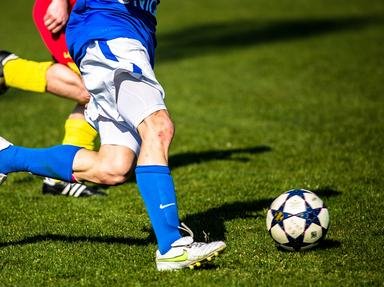Quiz Answer Key and Fun Facts
1. The Goalkeeper.
Colombian international René Higuita is credited with inventing an acrobatic move in which the goalkeeper makes a clearance by flipping his legs over his head and hitting the ball with his heels. The move, along with other antics, brought Higuita criticism as they caused unnecessary risk. How is Higuita's move widely known?
2. Right back.
Brazilian Marcos Evangelista de Moraes, aka Cafu, has won two FIFA World Cup titles. In 2001 he was involved in an unpleasant scandal involving false paperwork obtained to make it easier for him to play in Europe. The case went on for years, but he was finally acquitted. Which Italian team was he playing for in 2001?
3. Centre Back.
Norman Hunter was such a ferocious defender that he earned the nickname "bites yer legs" whilst playing for Leeds United thanks to a banner held up at the 1972 FA Cup final, a match which Leeds United won. Who did Leeds United beat in the 1972 FA Cup final?
4. Left Back.
West Germany World Cup winner Paul Breitner's revolutionary left-wing politics raised a few eyebrows in divided post-war Germany. In 1982, just before the FIFA World Cup, he lost a lot of kudos by agreeing to shave off his famous beard in an advert for a cosmetics company. Where was the 1982 FIFA World Cup held?
5. Right Winger.
Argentinian Claudio Caniggia was left out of the 1998 FIFA World Cup squad for refusing to cut his hair, but back in the 1990 World Cup during Argentina's opening game, he was fouled three times in one run. The third foul, by Benjamin Massing, took Caniggia down, and earned Massing a straight red card. Which team was Massing playing for?
6. Central Midfielder.
Irish international and Manchester United star Roy Keane earned an infamous reputation as a defensive midfielder who, when tackling, would enjoy taking his opponent's legs, and sometimes the ball. One of his most infamous tackles was on Norwegian defender Alf-Inge Haaland in April 2001. What match was it?
7. Midfielder.
Paul "Gazza" Gascoigne was playing for Newcastle United in a League Division One match in February 1988 when he was "manhandled" by a rival player. A photo of the incident has since been reprinted many times. Who was the legendary "football hard-man" who grabbed poor Gazza's private parts?
8. Left Winger.
French international Franck Ribery got into trouble for his involvement with an underage prostitute in 2010, just before the FIFA World Cup in South Africa. Quite amazingly, France got knocked out in the group stage without a single victory. Which of these teams wasn't in France's group, Group A?
9. Attacking Midfielder.
One of the all-time greats, Zinedine Zidane scored twice in France's FIFA World Cup Final victory over Brazil in 1998, and was involved in some key events of their 2006 FIFA World Cup Final loss to Italy. Which of these things is true about Zidane in that 2006 final?
10. Forward.
In January 1995, Manchester United legend Éric Cantona hit the headlines when he lunged into the crowd at a football match delivering a flying kick to Matthew Simmons, a supporter of Manchester United's opponents that day. Who were Manchester United playing against that day?
11. Forward.
In the 1986 FIFA World Cup, Diego Maradona scored two goals against England in the quarter-finals, knocking them out. The first was the infamous "Hand of God" goal, the second has been voted "Goal of the Century". On a club level, who was Maradona playing for in 1986?
12. Substitute Centre Back.
Spanish international Andoni Goikoetxea Olaskoaga, who played for the very successful Athletic Bilbao team of the early 1980s, is just the kind of defender you need if you need reinforcements, as very few players got past him unharmed. Which of these options was one of Olaskoaga's nick names?
13. Substitute midfielder.
Italian international Gennaro Gattuso really lost his rag in February 2011 when he was playing for Milan in a UEFA Champions League game against Tottenham Hotspur, and grabbed Joe Jordan by the throat on the pitch sidelines. Which team did both men play for in their careers?
14. Substitute winger/forward.
Senegalese international El Hadji Diouf has had more than his fair share of trouble. In March 2003, whilst playing for Liverpool in a UEFA Cup quarter-final match Diouf was caught on TV camera spitting at the rival team's supporters. Who were Liverpool playing that day?
15. The Manager.
Roman-born Paolo Di Canio started his career at Lazio in 1985, played in England from 1997 to 2004, and then went back to Lazio. In 2011 he was back in England, this time as a manager. As a player he often courted controversy, and it followed him into his managerial career when one of his new club's financial supporters stopped backing the club due to Di Canio's engagement as manager. Which team did he become manager of in 2011, his first appointment in that role?
Source: Author
thula2
This quiz was reviewed by FunTrivia editor
stuthehistoryguy before going online.
Any errors found in FunTrivia content are routinely corrected through our feedback system.
